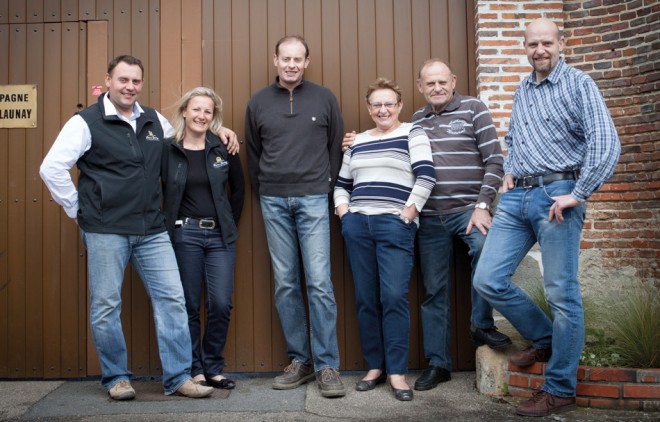
It is the story of three brothers, Laurent, Lionel and Jérôme. It is also the story of Pierre, the founding father. Then it is the story of a ‘terroir’, the Sezannais, a chalky coast at the southern end of the Marne region. Finally it is the story of a renaissance, that of viticulture and winemaking in this little corner of Champagne, largely unknown, but where quite a few major houses of Champagne discreetly come for their supply of grapes.
The story began in 1967 when Pierre Launay decided to reclaim a vineyard that had fallen out of grace. The Sezannais used to be a great vineyard until it was devastated by phylloxera. Winemakers pretty much disappeared and farmers went back to traditional agriculture focusing on wheat and beets. Pierre sought to preserve what he could of the local winemaking tradition. He invested in a few acres where he planted Chardonnay. He bought a press, second hand. With only a 2,000 kg capacity. His first bottles were released in 1973. Back then planting rights were generously allocated. Every year the domain got a little larger. Today it totals fourteen hectares, and vines are back all over the area. Today the little village of Barbonne-Fayel boasts the largest vineyard of all the Sezannais with over 260 hectares.
From 1992 on, two of Pierre’s sons, Lionel and Jerôme, joined him on the farm. Soon after Laurent, the eldest, joined them too. He handles finances and management. Jerôme is in charge of the vineyard and Lionel takes care of winemaking. There is also Céline, Jérôme’s wife who handles customer relations. And finally there is Madame Launay, the mother, who raised thoses three boys, not knowing that one day they would take over the domain and carry on. Being independant winemakers, the Launay brothers manage everything themselves, from the vine to the glass.
The Sezannais region is an extension of the ‘Côtes des blancs’. Its soil is chalky. Chardonnay feels right at home. Pinot Meunier, on the opposite, with its need of a richer soil, struggles. Therefore, only 2% of the Launay estate is planted in Pinot Meunier. To bring a little balance to their grape supply, the Launay brothers had to look 70 miles to the south-east and grow Pinot Noirs in Loches-sur-Ource and Buxeuil in the ‘Côte des Bars’ area.
They practice integrated agriculture and have begun the conversion process towards sustainable viticulture and HEV certification. Their goal is to produce the best Champagne possible, while respecting the terroir and the environment. Their tanks are made of enamelled steel. A material which was chosen over the cold and straight stainless steel because it can bring a little extra texture to a wine. For extra roundness still, some still wines will soon be aged in oak barrels for three to six months. The barrels will come from Burgundy, but the oak will originate from the Traconne forest, right in the Marne area, so as to build up the terroir identity.

Overtime Pierre built up a faithful customer base. His three sons did not want to give it up. So, rather than simply ending his range and substituting their own, they developed a new range to accompany the original one. Hence there are now two ranges of Pierre Launay Champagnes: the father’s is called the ‘Silver’ range because of its silver colored foil, it is pleasant and competitively priced; then there is the more premium ‘Gold’ range, that of the sons with its golden foil.
The entry level cuvee of the Gold range is named ‘Expression’. It is a blend of 70% Chardonnay and 30% Pinot Noir, also containing 30% of reserve wines. It has spent over three years aging on its lees. The palate is rich and fleshy and the long finish displays lemony tones.
The Grande Réserve 2006, a blend of 50/50 Chardonnay and Pinot Noir, is a reminder of an exceptional year. Its aromas are already evolved, with honey notes, the bubbles are infinitely fine, the palate is caressing and delicate, overall it is a wine which is at once delicate, elegant and fresh.
Still the ‘Blanc de Blancs’ vintage 2008 may be the greatest success of the Launay brothers to date. It is made from old vines dating back to 1962. Its dosage is at 2gr/l. All of the grapes come from a single area known as ‘Chatet’, a chalky hill in the village of Saudoy. Therefore it is a single vineyard wine even though hit does not claim it. Time has done wonders for those grapes. They give the wine its candied citrus nose, a harmonious palate, round and balanced, and a long finish full of freshness and minerality.
Pierre Launay’s legacy is in good hands.
Gérald Olivier
• 14 hectares
• 3 terroirs : limestone, chalk and clay
• grape varieties: 46 % Chardonnay, 51,5 % Pinot Noir & 2,5 % Pinot Meunier
• 2 presses: 4 000 & 8 000 kg
• 100% mechanic riddling
Markets:
- gamme ‘Argent’: old at the estate;
- gamme ‘Or’: HORECA & export